A Fierce Competitor: Controlling Wild Oat in Your Wheat
March 14, 2024
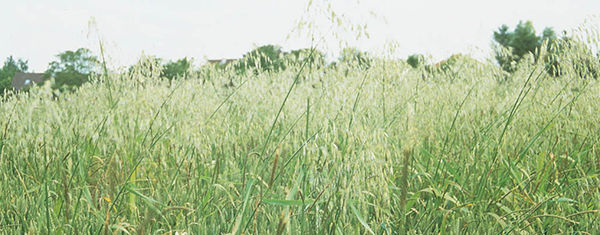
Wild oat is a highly competitive weed found scattered along ditches, highways and the edges of fields. It can severely infest fields, negatively impacting crop harvests.
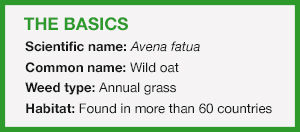
Damage and Economic Impact
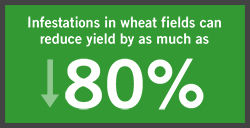
Wild oat competes for light, moisture and soil nutrients, which directly reduce crop yields.
Infestations can be found on 28 million acres of land across the United States.
According to a university report, annual losses to wild oat in North Dakota, the most infested state, are from $150 to $200 million annually.

Infestations in wheat fields can reduce yield by as much as 80 percent. Wheat yield can be reduced 6 percent by just one wild oat head per square foot. Highly infested fields containing 25 wild oat heads per square foot can suffer severe yield losses.1
Most yield reductions are incurred before the crop is 45 to 50 days old.1
Additional losses can be caused by increased tillage and herbicide use along with yield losses from delayed seeding. Elevators can impose price penalties for wild oat presence in grain.
Favorable Conditions for Germination
Wild oat will reproduce only from seed, and emergence is best in cool soil temperatures. Seed is released early – usually ahead of harvest – and lies dormant, which protects it from germination in the fall and from winter kill. Seeds have a second dormancy designed to stop germination in unfavorable conditions such as hot summer weather.
Wild oat typically does not produce more than 200 seeds per plant.1 But some cold-climate biotypes can remain viable for more than 10 years under certain field conditions.2

Identifying Wild Oat
Because damage occurs early with wild oat, early identification is critical to successful treatment. That said, seedling identification – especially in small grain crops – can be difficult. Look for these distinctive characteristics:
- Seed color is generally dark but can be as light as a cream color.
- Prominent hairs appear at the base of the seed, and a twisted and bent awn, or hairlike appendage, spikes upward from the back.
- An elongated sheath protecting the root tip allows wild oat to sprout more deeply in the soil than wheat and barley. University research has shown that wild oat can emerge from a soil depth of up to 9 inches.1
- No auricles are present.
- Leaves twist counterclockwise.
- Hairy leaves have a bluish hue.
- Blooms appear from March to June with a flower head that is open-branched with spikelets.
- Flowering spreads an open, drooping panicle.
- Wild oat usually grows to 1 to 4 feet in height, has an extensive root system and features thin, rough leaves.
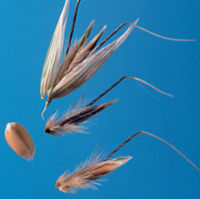

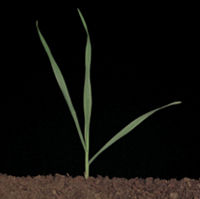
Known Resistance to Wild Oat
Wild oat has been reported as resistant to herbicides with the ACCase (Group 1) and ALS (Group 2) sites of action, according to university weed scientists.2 Wild oat populations have been found in Montana that are resistant to three modes of action: ACCase inhibitor, ALS inhibitors and difenzoquat (growth inhibitor).3
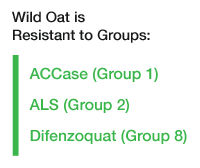
Managing Wild Oat
A combination of management techniques and herbicide use can help control wild oat populations. Following are several management tips to consider:
- Rotate crops if a severe infestation occurs. When rotating to hay, cut frequently to prevent wild oat from seeding.
- Avoid deep plowing of infested fields, as the seed can remain dormant but highly viable.
- Try minimum-tillage in infested fields.
- Establish a herbicide program with multiple, effective sites of action.
- Clean your field implements before moving from an infested field to another field.
Researchers are studying integrated weed management approaches to controlling wild oat, especially in oat fields where herbicide use would also damage the crop.
Bayer Solutions for Controlling Wild Oat in Wheat
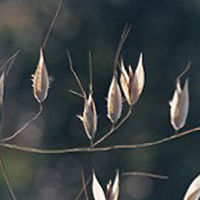
Bayer has a broad portfolio to combat tough-to-control and resistant weeds. Remember: Not every product is suitable for every situation and use of the correct application technique will ensure the best results.
A well-thought-out herbicide program, using multiple sites of action, should be implemented to sustainably manage weeds. Before applying any herbicide, please read the entire label for the best possible results and to confirm that the product is effective on the weeds you wish to control.
Start with a clean field by knocking out wild oats pre-planting with a pre-emergence application of either RT3® herbicide or Olympus® herbicide.
Keep fields clean and free from wild oats with a post-emergent herbicide application.
- Vios™ FX cereal herbicide offers the first Group 2 graminicide with an EC formulation to help control your toughest weeds and offer customizable weed control through its tank mix flexibility.
- Huskie® Complete herbicide (Groups 2, 6, 27) is an all-in-one wheat herbicide that includes Group 2 thiencarbazone to provide control of wild oat and other grasses. It also contains Groups 27 and 6, both known for their broadleaf weed resistance management properties.
- Wolverine® Advanced herbicide (Groups 1, 6, 27) effectively controls wild oat with its Group 1 component, and additionally manages broadleaf weeds in wheat. This wheat herbicide is an excellent tool to consider as a grass chemistry rotation partner to manage weed resistance.
Have questions about managing wild oat? Contact Bayer at 1-866-99-BAYER or send us a message through our online form.
ALWAYS READ AND FOLLOW PESTICIDE LABEL DIRECTIONS. Huskie® Complete is restricted use pesticides. Not all products are registered for use in all states and may be subject to use restrictions. The distribution, sale, or use of an unregistered pesticide is a violation of federal and/or state law and is strictly prohibited. Check with your local dealer or representative for the product registration status in your state. Tank mixtures: The applicable labeling for each product must be in the possession of the user at the time of application. Follow applicable use instructions, including application rates, precautions and restrictions of each product used in the tank mixture. Not all tank mix product formulations have been tested for compatibility or performance other than specifically listed by brand name. Always predetermine the compatibility of tank mixtures by mixing small proportional quantities in advance. Huskie®, Olympus®, RT3®, Vios™ and Wolverine® are trademarks of Bayer Group. For additional product information call toll-free 1-866-99-BAYER (1-866-992-2937) or visit our website at www.BayerCropScience.us. Bayer CropScience LP, 800 North Lindbergh Boulevard, St. Louis, MO 63167. ©2024 Bayer Group. All rights reserved.
Sources
1. Warrick, Billy E. and Baughman, Todd. "Wild Oat Control in Texas." 2003. https://sanangelo.tamu.edu/extension/agronomy/agronomy-publications/wild-oat-control-publication/
2. DiTomaso, J.M., G.B. Kyser et al. 2013. "Weed Control in Natural Areas in the Western United States." Weed Research and Information Center, University of California. http://wric.ucdavis.edu/information/natural%20areas/wr_A/Avena_barbata-fatua.pdf
3. Keith B.K., Lehnhoff E.A., Burns E.E., Menalled F.D., Dyer W.E. 2015. Characterisation of Avena fatua populations with resistance to multiple herbicides. Weed Research 55, 621–630. http://onlinelibrary.wiley.com/doi/10.1111/wre.12172/abstract